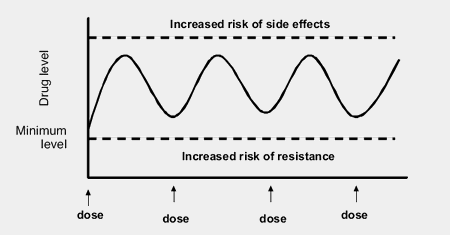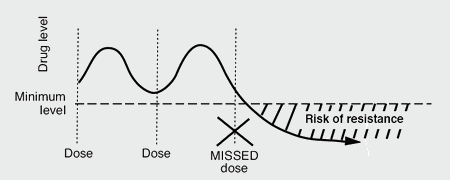
Drug levels, drug activity and side effects
On a very basic level, if drug levels are too low, then the drug will not be active enough to have any effect and there is a risk of resistance developing. If drug levels are too high, then the risk of some side effects is likely to be higher.
You are aiming to have a constant safe levels on drug whenever you are on treatment.

- Doses of a drug and how often you need to take a medication are designed to keep you in this target range.
- Different drugs have different target ranges.
- Drugs that leave your body quickly have to be taken more frequently and drugs that are processed more slowly can have longer dosing intervals.
- Some drugs – including HIV drugs, TB drugs, antibiotics and anti-fungal drugs have to be above a certain concentration, so that resistance doesn’t occur.
Drug levels in different people
There is often a very wide range of variability between different people who take the same dose of a drug.

- Some people will process the drug more quickly and get lower than average drug levels.
- Some people will process drugs more slowly and get higher than average levels.
- There can be differences in drug levels in the same person, even if the levels are measured at the same time after each dose – some drug levels are different 12 hours after a morning dose compared to 12 hours after an evening dose.
The average level for a drug involves a range of higher and lower concentrations.
This is because different people can absorb a drug differently.
Therefore some people can have a different risk of side effects or resistance from the same dose of a drug.

Drug levels in studies and product information
Studies and product information often shows a graph with details of drug levels. This shows information on how long it takes to reach the highest concentration after a dose, and how long the drug lasts in the body.

This graph shows that when atazanavir is boosted with ritonavir you get a higher maximum concentration of the drug, total exposure to the drug and lowest level of the drug for each dose of the active drug atazanavir.
The graph also notes the typical drug level needed in your blood to disable 90% of non-resistant HIV – ‘Median wild-type EC90=14 ng/mL’ (EC90 = the Effective Concentration needed to control 90% of the virus).
- The graph will show the average curve for drug levels.
- The graph will show the range of drug levels for each time these are sampled.
- It is important to remember that in individual people taking the drugs, the drug levels may not follow the average.
- Most studies on drug levels have small samples (number in the sample is indicated by the letter ‘n’). It is important to look at the sample size – a bigger sample = more accurate results.
Missing doses
A graph of drug levels can give you information about adherence and what happens if you are late with a dose or if you miss a dose completely.

- Occasionally missing or being late with a dose (say once a month) may not make very much difference.
- If you are missing or being late with a dose even once a week though, this will increase the time the virus has to develop resistance, and will increase the chance you will develop resistance over time.
- Adherence is not about doing things on time just because your doctor says so. It is about keeping minimum levels of each drug in your body 100% of the time that you are on treatment.
Therapeutic drug monitoring (TDM)
Therapeutic drug monitoring (TDM) is a test to measure drug levels in the blood.
- TDM is sometimes used to monitor people individually, and increase or decrease a drug’s dose as necessary.
- TDM is used to measure the levels of protease inhibitors and non-nukes.
- Routine TDM is not used for nukes. With some nukes, the levels in blood or plasma do not match the levels inside cells. The level of the drug active inside the cell is more important. This is more difficult to measure.
- TDM is especially useful in people who have kidney or liver damage, when drug interactions may be altering drug levels or when the best dose to use is not clear (eg for children).
- TDM is often used for pregnant women.
Last updated: 21 July 2009.
